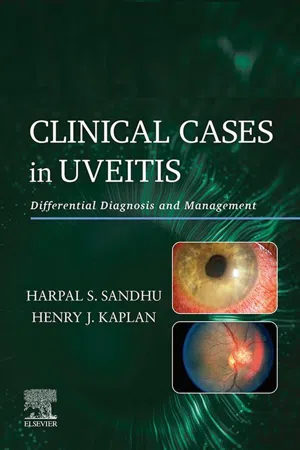
Clinical Cases in Uveitis E-Book
Differential Diagnosis and Management
- 400 pages
- English
- ePUB (mobile friendly)
- Available on iOS & Android
Clinical Cases in Uveitis E-Book
Differential Diagnosis and Management
About this book
Intraocular inflammation is particularly difficult to diagnose and treat, often resembling a complex puzzle of patient history, symptoms, imaging, and laboratory test results. Clinical Cases in Uveitis: Differential Diagnosis and Management is a unique, case-based resource designed to help you navigate the range of challenging manifestations and presentations that often mimic other diseases. More than 90 real-world uveitis cases are presented in a highly templated, easy-to-follow format, along with step-by-step guidance on the right patient questions, assessment, differential diagnosis, testing, management, and follow-up care.- Provides a variety of patient presentations and scenarios and unique clinical situations that mirror day-to-day practice.- Covers current diagnostic imaging modalities, including optical coherence tomography (OCT), optical coherence tomography angiography, fluorescein angiography (FA), and indocyanine green angiography (ICG).- Features diagnostic and management algorithms that assist in differential diagnosis and decision making for even the most complex cases, including those in which the patient does not improve as expected, prompting a reassessment of diagnosis and management.- Contains approximately 250 high-quality images, including color anterior segment photographs, color fundus photographs, OCT images, and angiograms.- Discusses distinguishing infectious from non-infectious inflammation; when and how to start systemic immunosuppressive therapy; diagnostic criteria and management of "white dot syndromes; pediatric uveitis; masquerade syndromes, including inherited retinal degenerations, malignancies, and paraneoplastic syndromes; and much more.- Includes the authors' specific thought processes and approach in particularly challenging cases.- An excellent resource and study tool for ophthalmology residents and fellows, those studying for oral boards, general ophthalmologists, retina specialists, and more.
Frequently asked questions
- Essential is ideal for learners and professionals who enjoy exploring a wide range of subjects. Access the Essential Library with 800,000+ trusted titles and best-sellers across business, personal growth, and the humanities. Includes unlimited reading time and Standard Read Aloud voice.
- Complete: Perfect for advanced learners and researchers needing full, unrestricted access. Unlock 1.4M+ books across hundreds of subjects, including academic and specialized titles. The Complete Plan also includes advanced features like Premium Read Aloud and Research Assistant.
Please note we cannot support devices running on iOS 13 and Android 7 or earlier. Learn more about using the app.
Information
Introduction to Uveitis
Abstract
Keywords

Approach to Diagnostic Testing
Abstract
Keywor...
Table of contents
- Cover image
- Title page
- Table of Contents
- Copyright
- Dedication
- List of Contributors
- Preface
- Acknowledgments
- Chapter 1. Introduction to Uveitis
- Chapter 2. Approach to Diagnostic Testing
- Chapter 3. Approach to Therapy
- Chapter 4. First Episode of Acute Iritis
- Chapter 5. Keratouveitis Secondary to Retained Lens Fragments
- Chapter 6. Cytomegalovirus (CMV) Anterior Uveitis
- Chapter 7. Chronic Anterior Uveitis
- Chapter 8. Hypopyon Uveitis
- Chapter 9. Herpetic Keratitis and Iritis
- Chapter 10. Juvenile Idiopathic Arthritis (JIA)
- Chapter 11. Tubulointerstitial Nephritis and Uveitis Syndrome (TINU)
- Chapter 12. Blau-Jabs Syndrome (Granulomatous Arthritis, Dermatitis and Uveitis)
- Chapter 13. Postoperative Uveitis
- Chapter 14. Bilateral Pigment Dispersion
- Chapter 15. Episcleritis
- Chapter 16. Refractory Scleritis in an Older Woman
- Chapter 17. Necrotizing Scleritis
- Chapter 18. Ebola Uveitis
- Chapter 19. Iris Mass and Panuveitis in a Child
- Chapter 20. Toxic Anterior Segment Syndrome
- Chapter 21. Pars Planitis
- Chapter 22. Lyme Disease
- Chapter 23. Amyloidosis
- Chapter 24. Retinoblastoma
- Chapter 25. Intraocular Foreign Body and Uveitis
- Chapter 26. Eales Disease
- Chapter 27. Posterior Scleritis
- Chapter 28. Multifocal Choroiditis with Panuveitis
- Chapter 29. Common Variable Immunodeficiency with Granulomatous Panuveitis
- Chapter 30. Sarcoidosis
- Chapter 31. Punctate Inner Choroidopathy (PIC)
- Chapter 32. Acute Posterior Multifocal Placoid Pigment Epitheliopathy (APMPPE)
- Chapter 33. Multiple Evanescent White Dot Syndrome (MEWDS)
- Chapter 34. Serpiginous Choroidits
- Chapter 35. Relentless (Ampiginous) Placoid Chorioretinitis
- Chapter 36. Uveitis with Subretinal Fibrosis Syndrome (USF)
- Chapter 37. Birdshot Retinochoroidopathy (BRC)
- Chapter 38. Autoimmune Retinopathy
- Chapter 39. Melanoma-Associated Retinopathy
- Chapter 40. Hemorrhagic Occlusive Retinal Vasculitis
- Chapter 41. Syphilitic Posterior Placoid Chorioretinitis
- Chapter 42. Syphilitic Uveitis and Outer Retinopathy
- Chapter 43. Tuberculous Uveitis
- Chapter 44. Diffuse Unilateral Subacute Neuroretinitis (DUSN)
- Chapter 45. Exudative Retinal Detachment
- Chapter 46. Endogenous Endophthalmitis
- Chapter 47. Acute Retinal Necrosis (ARN)
- Chapter 48. Progressive Outer Retinal Necrosis (PORN)
- Chapter 49. Toxoplasmosis
- Chapter 50. Severe, Atypical Toxoplasmosis
- Chapter 51. Toxocariasis
- Chapter 52. Systemic Lupus Erythematosus with Retinal Vasculitis
- Chapter 53. Cytomegalovirus (CMV) Retinitis
- Chapter 54. Vogt-Koyanagi-Harada Disease
- Chapter 55. Neuroretinitis
- Chapter 56. Acute Exudative Polymorphous Vitelliform Maculopathy
- Chapter 57. MEK Inhibitor-Associated Retinopathy (MEKAR)
- Chapter 58. Immune Checkpoint Inhibitor-Induced Panuveitis
- Chapter 59. Cysticercosis
- Chapter 60. Leptospirosis
- Chapter 61. Granulomatosis with Polyangiitis
- Chapter 62. Frosted Branch Angiitis
- Chapter 63. Susac Syndrome (Retinal Vasculitis, Hearing Loss, and Encephalopathy)
- Chapter 64. IRVAN Syndrome (Idiopathic Retinal Vasculitis, Aneurysms and Neuroretinitis)
- Chapter 65. Retinal Degeneration with Coats-Like Fundus
- Chapter 66. Congenital Zika Syndrome
- Chapter 67. West Nile Retinopathy
- Chapter 68. Dengue Retinopathy
- Chapter 69. Primary Vitreoretinal Lymphoma (PVRL)
- Chapter 70. Leukemia Metastatic to the Retina
- Chapter 71. New-Onset Macular Edema
- Chapter 72. Cystoid Macular Edema After Infectious Uveitis
- Chapter 73. Polypoidal Choroidal Vasculopathy (PCV) in SLE
- Chapter 74. Chronic Hypotony with Metastatic Melanoma and Checkpoint Inhibitor
- Chapter 75. Uveitic Cataract
- Chapter 76. Advanced, Undetected Steroid-Induced Glaucoma
- Chapter 77. Corneal Decompensation After Dexamethasone Implant
- Chapter 78. Epiretinal Membrane and Panuveitis
- Chapter 79. Globe Perforation After Sub-Tenon's Injection
- Chapter 80. Sterile Endophthalmitis
- Chapter 81. Contralateral Retinitis in a Patient on Systemic Immunomodulatory Therapy
- Chapter 82. Rhegmatogenous Retinal Detachment in Intermediate Uveitis
- Index